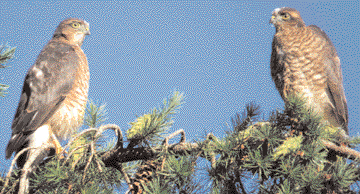|
Wildlife
Newsletter for the Township of Dalkey August 2014 - Michael Ryan |

|
We’d
been looking at the terns on Maiden’s Rock and thought we’d
drive up to the Vico to see if we could spot the Whitethroats which
had once again returned to nest in the dense bracken and gorse between
the path and the railway line. But it wasn’t the whitethroat
that got us excited. We hadn’t even pulled up before my companion,
Lucy, xclaimed there were dolphins in the bay! Sure enough there they
were, their dorsal fins breaking the surface as they lunged out of
the water. We thought for a while the little pod of three bottlenose
dolphins which attracted so much affection and excitement in Killiney
a few years ago had returned. But as we watched we realised there
were four dolphins here and the more we watched them we came to realise
that whatever they were, they weren’t the bottlenose. Although
they were breaching out of the water they weren’t as dramatically
exuberant as the bottlenose had been and their movements seemed slower
and more deliberate. Although they were moving away from us we had
the telescope and were able to follow their progress in it. The other
marked difference from the bottlenose were these dolphin’s dorsal
fins which seemed much taller and sickle shaped. In fact for a few
moments I actually wondered could we possibly be looking at Orcas,
or Killer Whales. We weren’t but it was the fact they resembled
which was the clincher when I rang a knowledgeable friend and described
them. He thought they might be Rissos dolphins and began to describe
them saying they were often mistaken for Orcas. There had been regular
sightings of a pod of Rissos along the east coast and from his description
I’m certain that’s what we were looking at. As we watched
them swim away they seemed to breach and dive in unison and looked
like they were swimming four abreast, the four tall fins appearing
out of the sea like a synchronised swimming team. A chap walked up
from the beach almost in a daze with excitement after seeing them.
he told us he’d never seen dolphins before and these had come
in very close to the shore giving a great display. Haven’t seen
them since but it certainly makes a scan of the sea potentially more
exciting and there’s frequently porpoise passing by to have
a look at even if we don’t see any dramatic dolphins. |
 Juvenile Jay on Squirrel Feeder Photo: Michael Ryan |
We don’t know what happened or why they left but it was sad after
such a hopeful beginning. I mentioned in the June issue we’d spotted
a Jay’s nest which was situated less than thirty yards from a
Sparrowhawk’s nest and despite their proximity to each other both
pairs succeeded in fledging young, the jays a few weeks before the hawks.
We could have picked up the first young jay we saw which was actually
walking along the ground while the parents moved through the trees keeping
a concerned eye on their offspring till it hid itself in a bramble patch.
I’d seen this behaviour before a few years ago, a young jay walking
rather than flying as it’s siblings and parents moved through
the trees and it seemed a very perilous thing to be doing. I contacted
someone who’d done a thesis on jays and he said yes, he’d
seen that a few times with jays he’d been studying. Maybe the
young develop separately and the last one leaves whether it’s
ready or not. Anyway we saw at least four young jays a few days after
and they were certainly very capable flyers and all doing well, one
going into a squirrel feeder cage to help itself to the hazel nuts left
to entice the squirrels. |